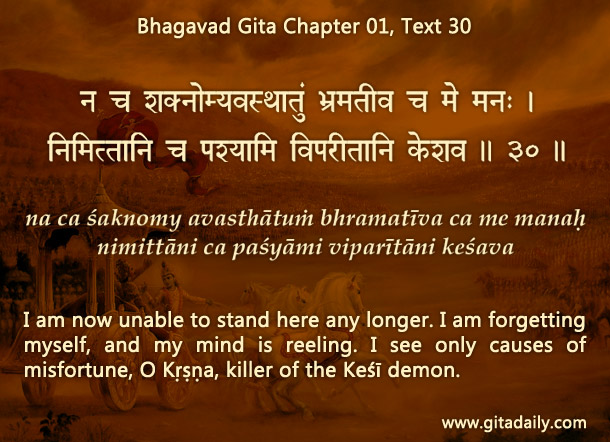The Bhagavad-gita’s chariot setting symbolizes its universality. The theme of a warrior on a chariot counseled by the charioteer harkens to a well-known Upanishadic metaphor comparing the body with a chariot. In this visually evocative comparison, the horses are equated to the senses; the reins, to the mind; the charioteer, to the intelligence; the passenger, to the soul.
For a chariot to serve its function of taking the passenger to the desired destination, the charioteer needs to be skilled and strong enough to control and direct the horses. Similarly, for us to achieve our goals, our intelligence needs to be strong enough to control our senses. But our problem is twofold: our intelligence is not strong enough, and our understanding of what goals are worthwhile is not clear enough.
The Bhagavad-gita’s setting demonstrates a situation when Arjuna’s intelligence was bewildered; he foresaw disaster in every possible course of action (01.30). After hearing the Gita (18.73), Arjuna despite being the warrior agreed to do the bidding of his charioteer – he understood that the charioteer was God and was the supreme intelligence and the source of all intelligence.
To apply the Gita’s essential message as demonstrated through its thematic setting, we can entrust the reins of our chariot to Krishna. That is, we can equip our intelligence with the divine intelligence manifested in Krishna’s words of the Gita. By regular Gita study, when we imbibe its worldview and let it inform our living and even thinking, then our perceptions and decisions will gradually be shaped and guided by Krishna’s intelligence. With him at the helm of our chariot, we will find our way even through overwhelming perplexities, for he will give us the intelligence to go through and grow through whatever life sends our way.
To know more about this verse, please click on the image
Explanation of article:
Podcast:


Pranaama ‘Krisha saarathi’ is the most moving metaphor of Vishnu’s Grace
Dhanya Dhanya